

A geometry of shale dome (Plate 89) induces important lateral and vertical changes in velocity intervals. Due to diapirism, low velocity sediments will be pushed-up and juxtaposed to higher or lower velocity sediments. A planar bottom of a shaly facies, either horizontal or tilted on time seismic, generally has a pull-down geometry (Plate 90).
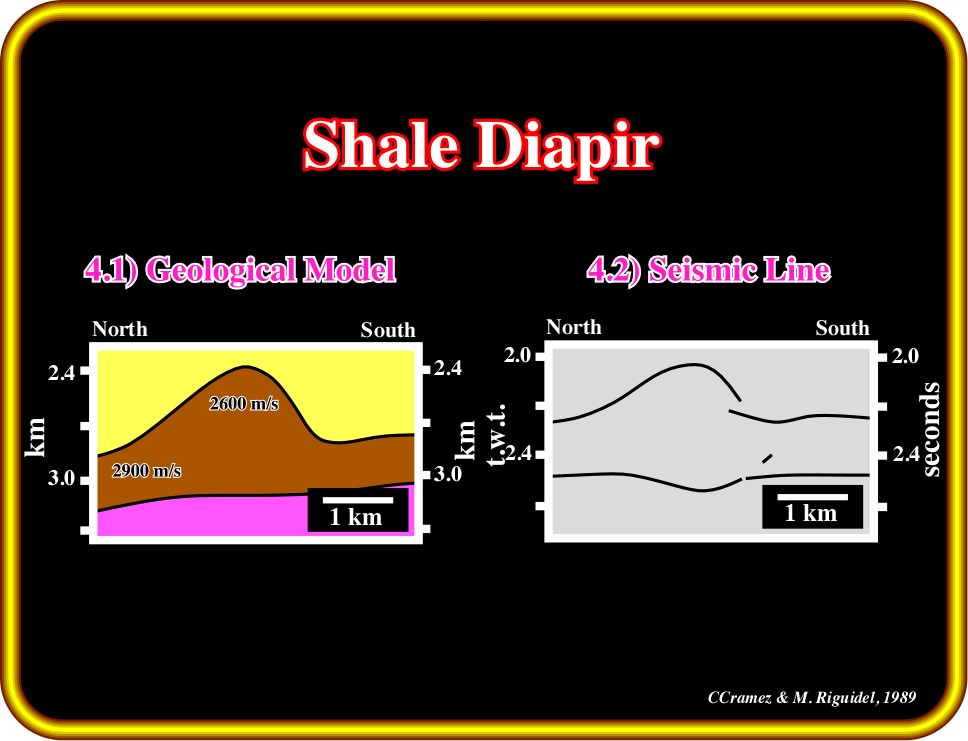
Plate 89- On this figure are illustrated a geological model of a shale mound (left) and the equivalent seismic line (right). On the geological model, the shale interval (brown) has velocities ranging between 2600 and 2900 m/s, with the lower velocities in the top of the structure. Assuming the velocity interval of the yellow interval above the shaly mound is constant, there is a significant increasing lateral changing in the velocity with the shale interval above 2.7 km. On a seismic line, the interface between the shale interval (brown) and the underlying sediments (violet), show a pull-down at the vertical of the shale dome.
In the majority of the cases, it is very difficult to see the root of the shale domes. On unmigrated lines, due to the complex geometry of the reflections associated with the top of the shale, only the uppermost part, i.e., the apex of the reflection associated with the domes, is in its real time position.
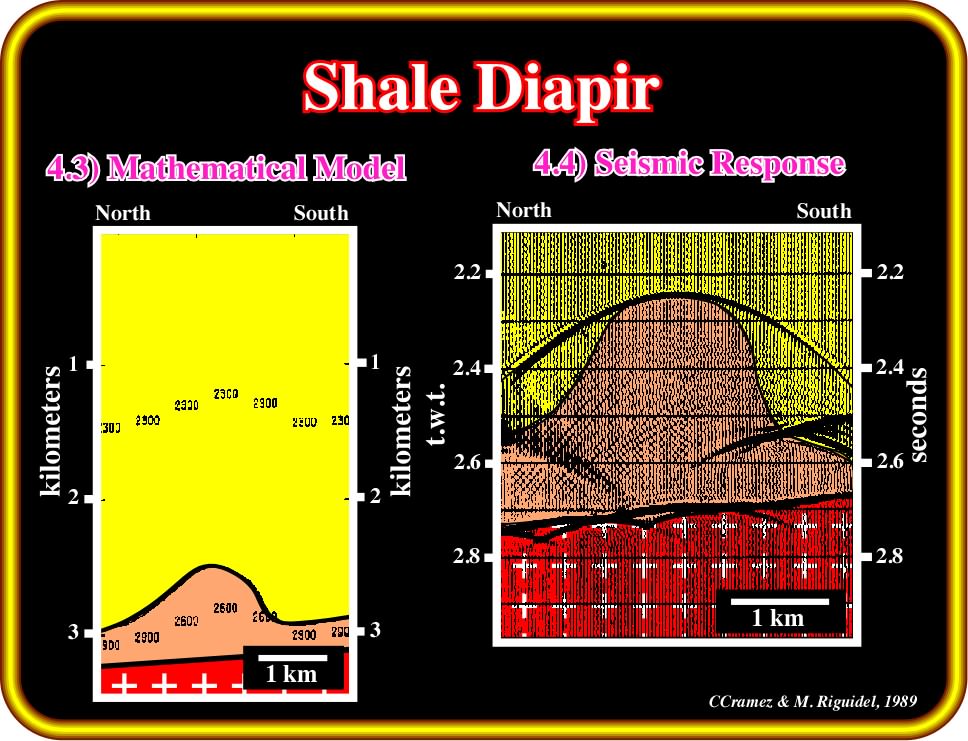
Plate 90- In the velocity model (left), the yellow sediments above the shale mound have a constant velocity of 2300 m/s. The velocity in the shale interval is 2600 m/s, in the upper part, and 2900 m/s, in the lower part. The seismic response of such a mathematical model indicates the velocity contrasts are not big enough to significantly pull-down the bottom of the shale interval, directly, below the apex the vertical of the mound. The seismic response is unmigrated. Only the apex of the mound is in its real position.
In certain sedimentary basins with evaporite layers, salt and shale domes can be present with similar geometries. One of the best ways to differentiate them is to look at the seismic markers emphasizing their bottoms. Generally, the base of a shale dome has a pull-down geometry, while the bottom of salt dome shows a pull-up geometry. The bottom of salt domes are easier to recognize.
A tentative interpretation of a seismic line with a salt dome and the correlative depth conversion (more or less, the geological model) are illustrated on Plate 91. The tentative interpretation (on the right) shows seismic anomalies associated with salt thickness variations.
On this particular example, the salt interval, which has a velocity of 4580 m/s, is overlain by sediments with calcareous facies that has a high compressional wave velocity (around 5480-4870 m/s). When the salt flows, laterally, it becomes, locally, thinner and the result is a pull-down of the reflectors (the seismic waves travel in the salt, relatively, slower than in limestones).
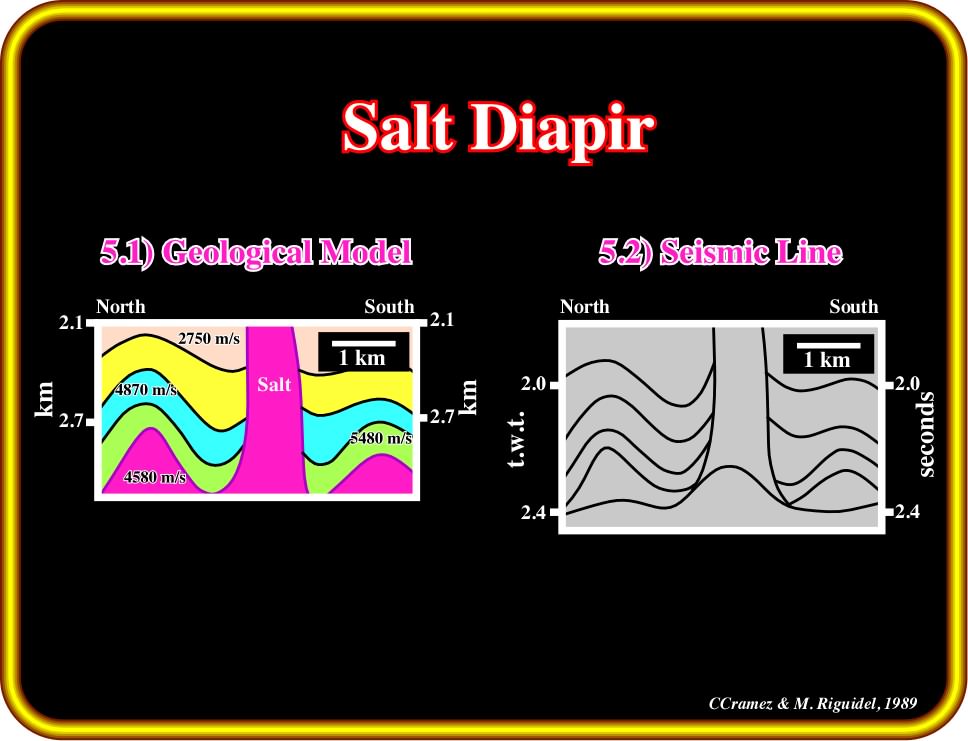
Plate 91- In the geological model, the compressional wave velocity in the salt is constant and equal to 4580 m/s. The density of the salt ranges between 2.15 and 2.17 g/cm3. In addition, salt cannot be compacted, i.e., its density is constant. The velocity of the seismic waves doe not change in depth when traveling trough salt. The velocity interval of the supra-salt strata is supposed to be laterally constant. On the seismic line of such a geological model, illustrated on the right, the bottom of the salt layer is undulated: it is pulled-up under thick salt.
When there is an up-ward movement of the salt, it is juxtaposed to sediments with a lower compressional wave velocity and the final result is a pull-up of the reflector associated with the bottom of the salt. When a salt layer is not isopach, the bottom of the salt is pulled-up at under the thick salt sectors and pulled-down where the salt is thin or not present (salt weld).
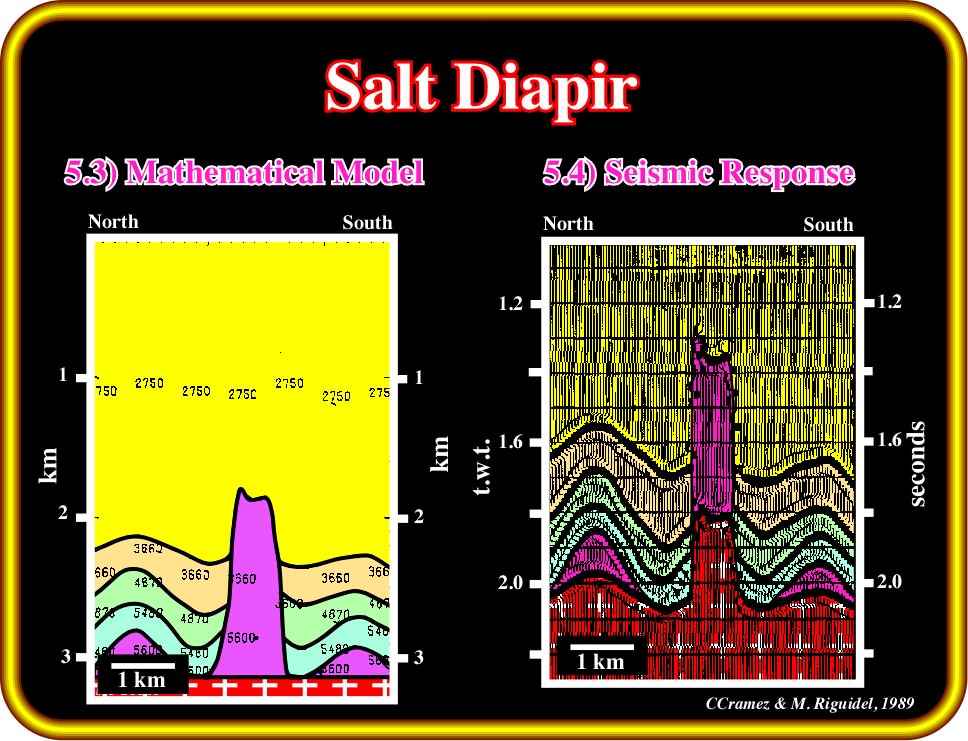
Plate 92- The seismic response to the geological model is quite evident. The bottom of the salt, particularly, under the apex of the salt dome, is pulled-up almost 0.2 seconds (t.w.t.). The salt welds (absence of salt due to lateral and vertical flowage) are slightly pulled-down. This geological model of a salt dome with vertical flanks is unrealistic. Due to the fact that salt cannot be compacted, salt structures with vertical flanks are a physical impossibility. In the lower part, below the inversion density point, the pressure of the sediments against the salt is higher than the pressure of the salt against the sediments. On the contrary, in the upper part, above the density inversion point, the pressure of the salt against the sediments is higher than pressure of the sediments against the salt. A drop salt structure (detached salt stock) is developed, which can be or not disconnected of the salt mother rock with formation of a secondary (vertical) salt weld.
The velocity model and its correlative seismic answer illustrated in plate (Plate 92) depict the causes of apparent wavy geometries on the bottom of evaporitic packages on time lines (unmigrated or not). Just a depth-converted seismic line shows a. more or less, rectilinear base of evaporitic intervals, if the velocity interval field (velocity interval of all sedimentary packages) is well known.
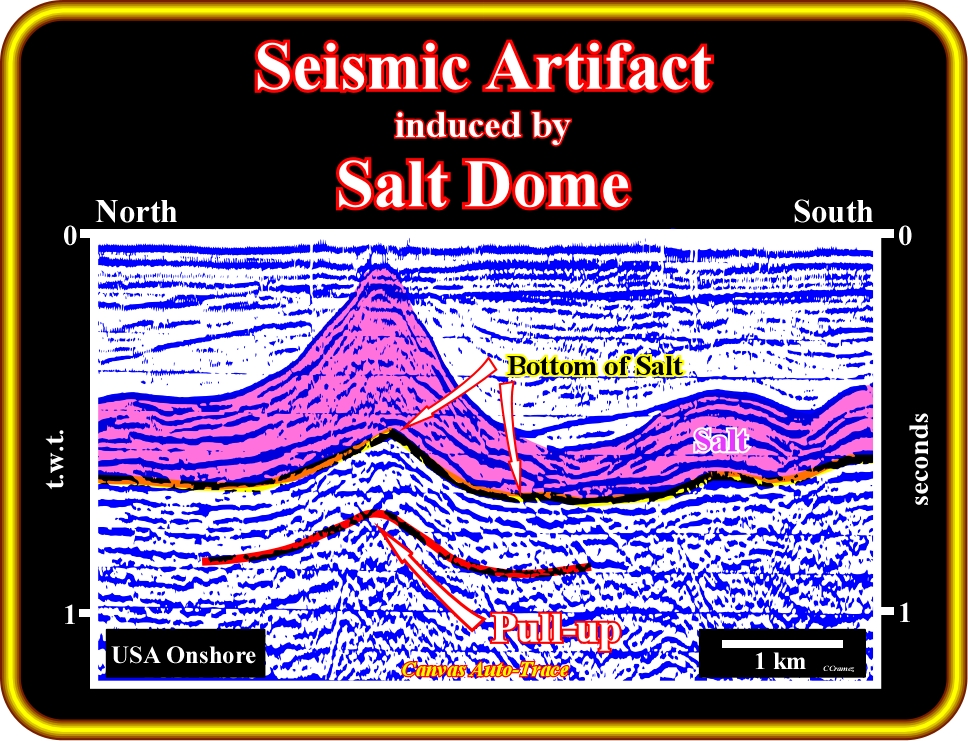
Plate 93- This tentative interpretation of an aut0o-trace of a seismic line of Louisiana onshore (USA) illustrates the seismic artifact induced by a non isopach evaporitic interval. The bottom of the salt layer is pulled-up where the salt interval is thicker. The seismic waves traveling through a thicker high velocity interval (± 5000 m/s) spend less time : the base of the salt is pulled-up.
The above auto-trace comes from a sedimentary basin wit a significant salt layer, in which lateral changes in thickness are frequent. These thickness changes induce lateral changes in the velocity interval, which cause obvious seismic artifacts. Without a corrected time-depth conversion, it is sometimes dangerous to assume, a priori, a flat salt bottom. In Angola offshore, for instance, in infra-salt strata, steps are often present, in association, with major fracture zones or carbonate buildups, which are fossilized by onlapping of the salt. The same is true in Brazil offshore (Santos geographic basin) as suggested, recently, by Brazilian geoscientists.
The development of reefs or organic build-ups, in which the seismic waves have, often, a high velocity, induce important pull-ups of the horizons associated with their bottoms, as sketched in Plate 94. On the ground and on in geological models, the bottoms of the reefs have planar geometries.
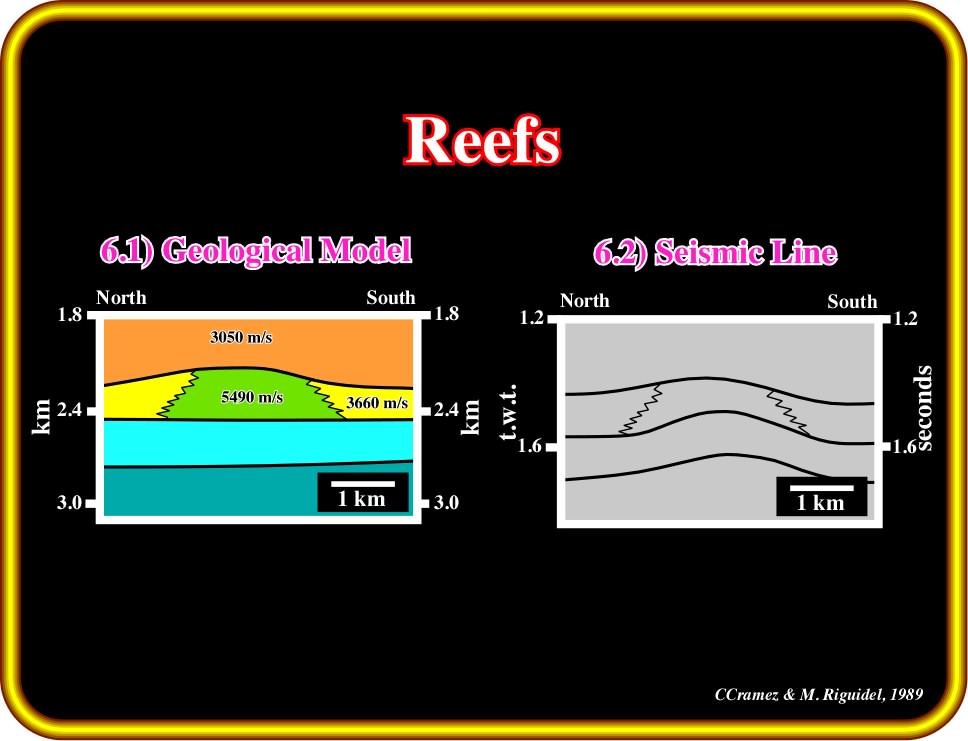
Plate 94- On this reef geological model, above a planar limestone sole (light blue), a reef with a compressional wave velocity of 5490 m/s, is laterally bounded by shaly sediments (yellow) with a much lower velocity (3660 m/s). The upper brown interval has a lower interval velocity ( 3050 m/s). The seismic answer of this model is, roughly, depicted on the right. The horizon associated with the bottom of the reef shows a significant pull-up.
This geometry, with a pull-up of the bottom of the reef, is normal when the reef is developed adjacent to a low velocity interval such as a shaly interval. If a porous reef is developed within a tight calcareous interval, the geometry of the bottom of the reef is inverted, i.e., the associated marker, if there is a marker, is pulled-down.
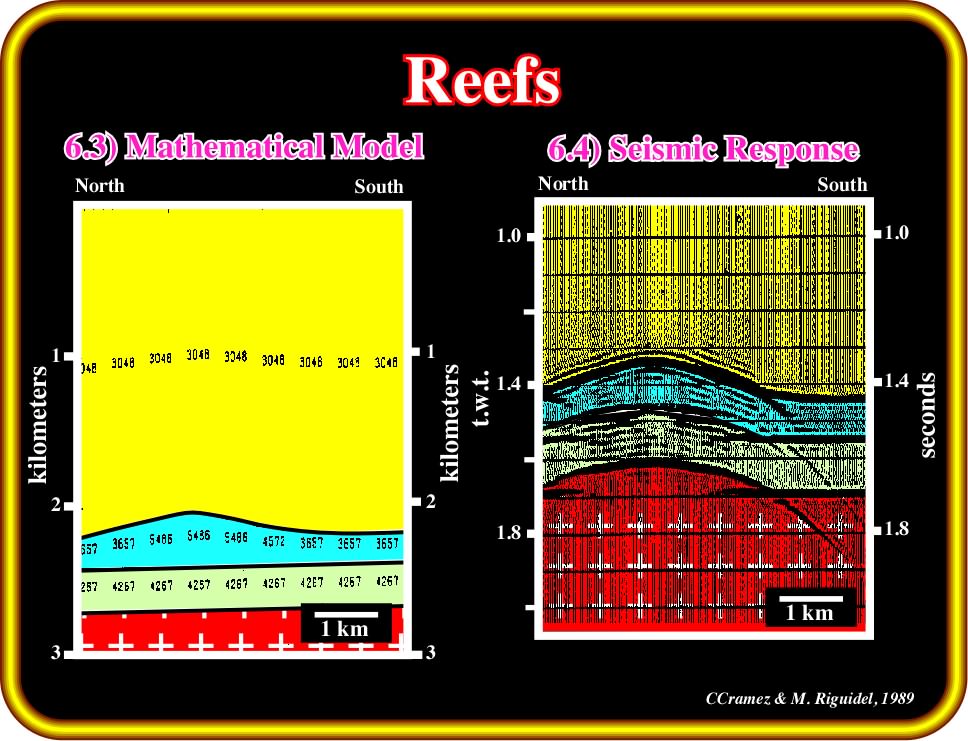
Plate 95- In the geological model (left) the compressional wave velocity, in the blue interval (limestone with a local reefal development) changes significantly. It is much higher (around 5500 m/s) in the reef than in the surrounding sediments. Such a reef is supposed to be tight. The seismic response of such a model, on the right of the figure, shows that not only the bottom of the reef, but all others markers below are pulled-up.
In certain basins, for instance, in the Michigan basin (USA), the recognition of reefal anomalies is mainly based in the absence of reflector. When, continuous and high amplitude markers, emphasizing a limestone interval, show significant abrupt interruptions, they may be due to the presence of a local porous reef.
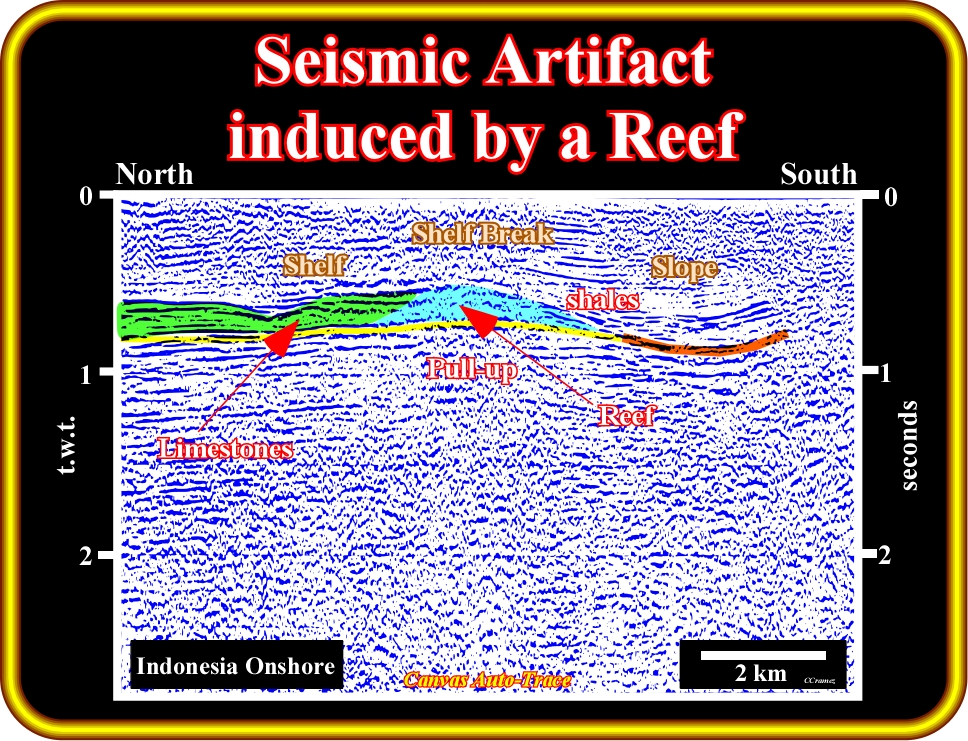
Plate 96- On this auto-trace of seismic line, from Indonesia offshore, the shelf break of the upper colored interval seems to emphasize the development of a reef. The bottom of the shelf limestone is pulled-up. This pull-up is enhanced by the pull-down of the reflectors associated with the slope shales (in brown).
On this tentative interpretation of the above auto-trace of seismic line (Plate 96), the pull-up of the bottom of the reef is very sharp, as is the time thickness interval of limestone facies, which is, clearly, thicker in the velocity model. This kind of seismic artifact occurs very often near the platform limit-upper slope (see Ashstart field, in Tunisia offshore), where shelf margin reefs build-up, particularly in regressive stratigraphic intervals.